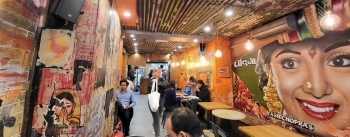Comparing kebab rolls in London’s Soho with those in Kolkata
ACCORDING TO ITS website, the small restaurant in Soho’s Poland Street called The Kati Roll Company (‘KRC’):
“… serves authentic street Kati Rolls just like the ones in Kolkata, India.”
The restaurant is attractively decorated, with its wall covered with fragments of Hindi film posters and a corrugated iron ceiling. It has several tables and chairs. Food is ordered from a counter at the far end of the rectangular dining area, and is delivered a few minutes later. I could not see the kebabs being prepared, but if they are truly kati kebabs, they should have been grilled on bamboo skewers. The roll, wrapped in paper consists of a spicy meat or vegetarian filling enclosed in a rolled-up roti, which the restaurant described as a ‘paratha’.
 Kati Roll Company, London
Kati Roll Company, LondonKRC was, according to its website, started:
“… by Payal Saha shortly after she moved from her hometown of Kolkata to New York City. Without any experience running a restaurant, she let her desire for authentic kati rolls drive her passion.”
Well, it was with great interest that today, 3 September 2025, I visited and ate at KRC in Poland Street. I was curious to see how their rolls compared with those at Nizams in central Kolkata. I have written quite a lot about this restaurant in my latest book “88 Days in India: A Journey of Memory and Discovery”. Here is a short excerpt from my description of the rolls at Nizams:
“The kathi roll consists of a kebab (usually chicken or mutton, or potato for vegetarians) wrapped, with or without a cooked egg (like an omelette), in a rolled up flaky paratha. Onions and chillies can also be included in the roll. The paratha is heated in a large amount of oil on a tava (a circular, concave metal hotplate). It is the same one that was installed when the restaurant first opened. According to an article in The Telegraph Online (dated August 2024), the tava weighed 185 Kg in 1932, but through constant use it has lost weight. By 2024, it weighed 80 Kg. Until 1964, the kebabs were grilled on iron skewers. After that, the metal skewers were replaced by cheaper bamboo sticks, known in Bengali as ‘kathi’. The rolls have always been served, wrapped up in paper so that the customers (often in the early days, British men out on the town with Indian ladies) did not get grease on their fingers whilst consuming them. Interesting as the history is, it pales into insignificance when you bite into one of Nizam’s kathi rolls. I do not know how they achieve it, but the taste of Nizam’s kebab filled rolls surpasses that of every other kebab roll I have eaten. Year after year, Nizam’s manages to maintain the high quality and magical flavour of their products.”
After having eaten at Nizams many times, I waited with great interest for the 4 kathi rolls we had ordered in Poland Street to be served.
The fillings in the KRC rolls were tasty enough, and if you have never eaten at Nizams, you would think that they taste pretty good. The so-called parathas in which KRC’s rolls are wrapped seemed more like rotis than what I was expecting. In contrast, the parathas that enclose the fillings at Nizams are, as mentioned above, flaky, almost as much as Malabar or Kerala parathas, but oilier. Although I enjoyed the rolls at KRC, and will happily eat there again, they are not nearly as satisfying and tasty as those at Nizams. However, it is much easier and quicker for us to reach KRC in Soho than it is for us to get to Nizams in Kolkata.
PS: My book, which contains a chapter about eating in Kolkata, is available from Amazon:



